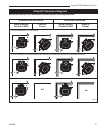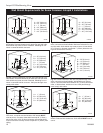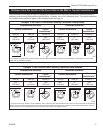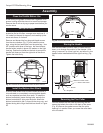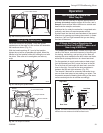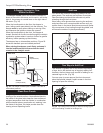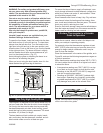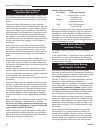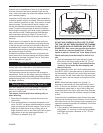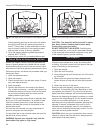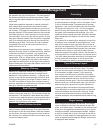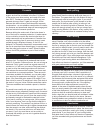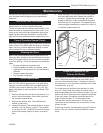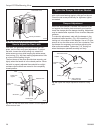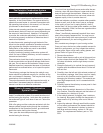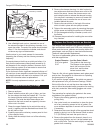
23
Intrepid II Woodburning Stove
2000966
produce soot or large flakes of char or fly ash that can
coat the combustor and cause smoke to spill into the
room. Coal smoke also can poison the catalyst so that it
won’t operate properly.
In general, the fire must be sufficiently well-established
to ensure catalytic activity is initiated. When first starting
a fire, maintain a medium- to high- firing rate for at least
twenty minutes. This ensures the stove, catalyst, and
fuel are all stabilized at the proper operating tempera-
tures. This may be long enough to warm the chimney
well enough to support a good draft; some installations
may need more time. Please read the Draft Manage-
ment information starting on Page 25 to see if your
installation has features that may require more time to
warm up.
Even though it is possible for the fire to get quite hot
within a few minutes, the combustor may stop working
or the fire may go out if the fire is allowed to die down
immediately as a result of closing the damper. Once the
combustor starts working, heat generated by burning
the smoke will keep it working.
To determine whether the combustor is operating, ob
-
serve the amount of smoke leaving the chimney when
the damper is activated and when it is not. This proce-
dure is described on Page 29.
Conditioning Your Stove
Cast iron is extremely strong, but it can be broken with
a sharp blow from a hammer or from the thermal shock
of rapid and extreme temperature change.
The cast plates expand and contract with changes in
temperature. When you first begin using your Intrepid II,
minimize thermal stress by allowing the plates to adjust
gradually during three or four initial break-in fires follow-
ing Steps 1-3 below.
Starting and Maintaining a Wood Fire
Burn solid wood fuel only in the Intrepid II, and burn it
directly on the grate. Do not elevate the fuel. Do not
burn coal or other fuels.
The damper must be open when starting a fire or
when refueling.
1. Open the stove damper, and open the primary air
control fully.
2. Place several sheets of crumpled newspaper in the
stove. Do NOT use glossy advertisements or colored
paper, as they can poison the catalyst. Place on the
paper six or eight pieces of dry kindling split to a
finger-width size, and on the kindling lay two or three
larger sticks of split dry wood approximately 1-2”
(25-50mm) in diameter. (Fig. 39)
ST263
starting a fire
12/99
ST263
Fig. 39 Start the fire with newspaper and dry kindling.
DO NOT USE CHEMICALS OR FLUIDS TO START
THE FIRE. DO NOT BURN GARBAGE OR FLAMMA-
BLE FLUIDS SUCH AS GASOLINE, NAPHTHA, OR
ENGINE OIL. Also, never use gasoline-type lantern
fuel, kerosene, charcoal lighter fluid, or similar
liquids to start or “freshen up” a fire. Keep all such
liquids well away from the Intrepid II while it is in
use.
3. Light the newspaper and close the door. Gradu
-
ally build up the fire by adding a few 3-5” (76-127
mm) diameter splits. If this is one of the first few
“break-in” fires, let the fire burn brightly, and
then let it die out.
During the break-in fires, don’t let the stove get hotter
than 500°F (260°C) as measured on an optional stove-
top thermometer. Adjust the air control lever as neces-
sary to control the fire. Some odor from the stove’s hot
metal, the paint, and the cement is normal for the first
few fires.
NOTE: Some chimneys need to be “primed,” or
warmed up, before they will draw sufficiently to start
a fire. To correct this situation, roll up a couple pieces
of newspaper, place them on top of the kindling and
toward the back of the stove, light them, and close the
doors. This should heat the chimney enough to initiate
a draft.
Once the draft is established, open the front door and
light the rest of the fuel from the bottom. Do not light the
main bed of fuel until the chimney begins drawing, and
repeat the procedure as often as necessary if the initial
attempt is unsuccessful.
4. If your Intrepid II has been broken-in previously
using Steps 1-3, continue to build the fire gradually.
Add larger wood with a diameter of 3-4” (76-102
mm). (Fig. 40)



